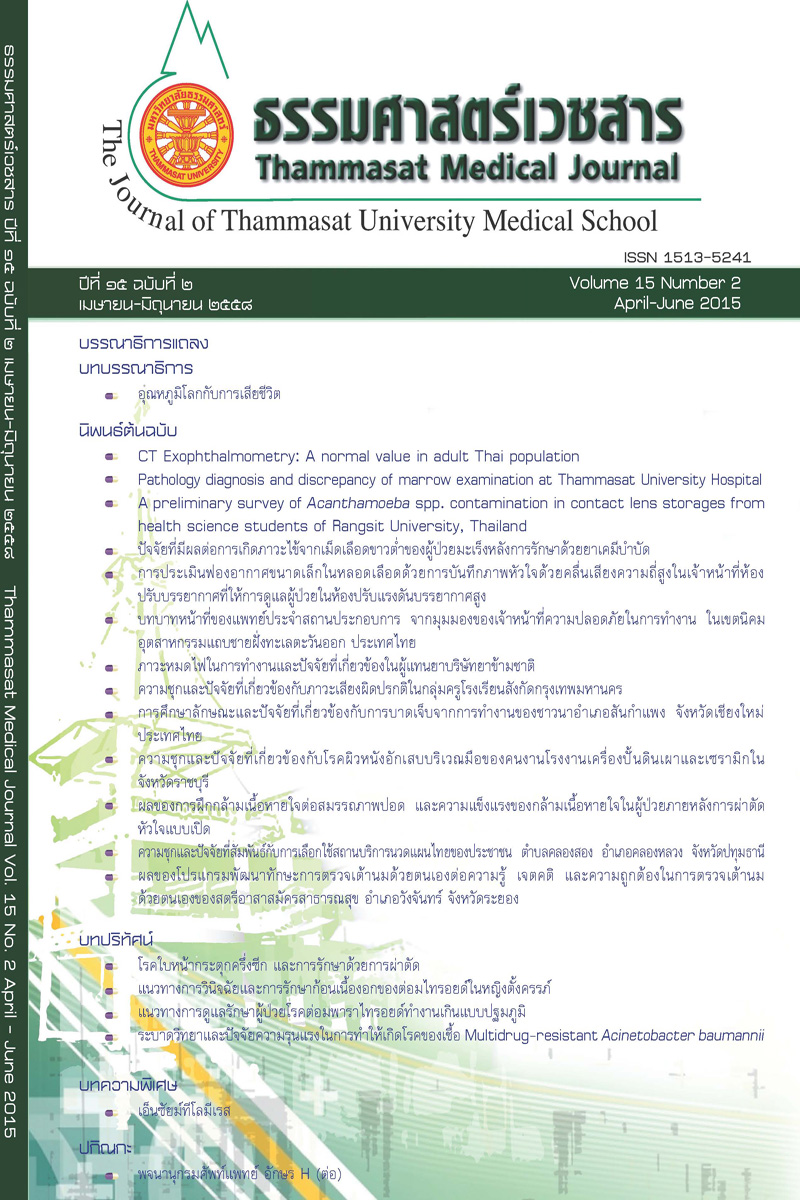CT Exophthalmometry: A normal value in adult Thai population
Keywords:
Exophthalmometry, Proptosis, Orbital CT, ตาโปน, ตาโปนข้างเดียว, ภาพเอกซเรย์คอมพิวเตอร์กระดูกเบ้าตาAbstract
Introduction: Hertel exophthalmometry is the most frequently used tool in evaluation of proptosis but there has been reports of its low reliability and less reproducibility. Since computed tomography (CT) has become a widely used technique for imaging of the orbit, we therefore conducted this study to find normal value of proptosis in Thai people on CT.
Method: One hundred fifty-two subjects with normal CT scan of brain during May 1, 2011 - September 30, 2012 were enrolled. Seventy-three were male (age 21 - 74 years) and seventy-nine were female (age 20 - 85 years). Several parameters of exophthalmometry on orbital CT were measured.
Result: Mean protrusion value was 17 mm in male group, and 16.45 mm in female group. There was no statistically significant difference in all parameters between right and left eyes.
Discussion and Conclusion: Although this study found normal range of proptosis on CT in Thai population, the cutoff value for determining exophthalmos is still not known. In addition, there are several factors that influence the protrusion other than diseases such as height, weight, facial contour. Future study is therefore needed to find the cutoff value. However, the normal range of orbital CT exophthalmometry parameters from this study will still be useful to serve as an available general reference for orbital CT interpretation.
Key words: Exophthalmometry, Proptosis, Orbital CT
การศึกษาภาพเอกซเรย์คอมพิวเตอร์เพื่อหาค่าปรกติการยื่นออกมาทางด้านหน้าของลูกตาจากกระดูกเบ้าตาในคนไทย
อุทัยรัศมิ์ เชื่อมรัตนกุล, อภิชญา ศรีปริวุฒิ
ภาควิชารังสีวิทยา คณะแพทยศาสตร์ มหาวิทยาลัยธรรมศาสตร์
บทคัดย่อ
บทนำ: การยืน่ ออกมาทางดา้นหนา้ของลูกตตาที่มากผิดปรกติหรือทีีเรียกว่า “ตาโปน” สามารถพบได้จากหลายสาเหตุปัจจุบันการวัดค่าการยื่นของลูกตาใช้เครื่อง Hertel exophthalmometer เป็นตัววัด ซึ่งวิธีการนี้มีงานวิจัยบางฉบับรายงานว่ามีค่าคลาดเคลื่อนจากการวัดได้ซึ่งมีผลต่อการวินิฉัยโรคและการตรวจติดตามผู้ป่วย ในปัจจุบันโรคทางจักษุวิทยาบางโรคผู้ป่วยจะถูกส่งมาทำเอกซเรย์คอมพิวเตอร์ก่อนให้การรักษา ซึ่งการจะวินิจฉัยให้ได้ว่า ผู้ป่วยมีการยื่นของลูกตามากผิดปรกติหรือไม่นั้น จำเป็นจะต้องทราบค่าที่ปรกติก่อน ทั้งนี้ยังไม่เคยมีการศึกษาค่าปรกติการยื่นของลูกตาในคนไทยจึงทำให้ทางผู้วิจัยสนใจทำการศึกษาในเรื่องนี้ วัตถุประสงค์เพื่อหาค่าปรกติ การยื่นออกมาทางด้านหน้าของลูกตาจากกระดูกเบ้าตาด้วยภาพเอกซเรย์คอมพิวเตอร์และเทียบค่าความแตกต่างระหว่างสองตาและเพศ
วิธีการศึกษา: เอกซเรย์คอมพิวเตอร์สมองที่ผลปรกติของผู้ป่วย ๑๕๒ คน ที่ทำการตรวจตั้งแต่ ๑ พฤษภาคม พ.ศ. ๒๕๕๔ ถึง ๓๐ กันยายน พ.ศ. ๒๕๕๕ โดยเป็นเพศชาย ๗๓ คน (อายุระหว่าง ๒๑ - ๗๔ ปี) และเพศหญิง ๗๙ คน (อายุระหว่าง ๒๐ - ๘๕ ปี) ภาพเอกซเรย์คอมพิวเตอร์ในท่าตัดขวางจะถูกนำมาวัดค่าตามที่กำหนด
ผลการศึกษา: ค่าเฉลี่ยการยื่นของลูกตาในผู้ชายและผู้หญิงเท่ากับ ๑๗ มิลลิเมตร และ ๑๖.๔๕ มิลลิเมตร ส่วนค่าอื่นที่วัดได้เมื่อเทียบกันระหว่างตาซ้ายและขวาไม่แตกต่างกันอย่างมีนัยสำคัญทางสถิติ
วิจารณ์ และสรุปผลการศึกษา: ค่าที่ได้จากการวิจัยนี้มีประโยชน์สำหรับใช้เป็นเกณฑ์อ้างอิงเพื่อประกอบการแปลผลการยื่นออกมาทางด้านหน้าของลูกตาจากกระดูกเบ้าตาของคนไทยด้วยภาพเอกซเรย์คอมพิวเตอร์ แต่อาจจะยังไม่สามารถนำมาเป็นเกณฑ์การวินิจฉัยภาวะตาโปนได้ เพราะยังมีปัจจัยอีกหลายประการที่ส่งผลต่อการยื่นของลูกตาซึ่งควรมีการศึกษาต่อไป
คำสำคัญ: ตาโปน, ตาโปนข้างเดียว, ภาพเอกซเรย์คอมพิวเตอร์กระดูกเบ้าตา



